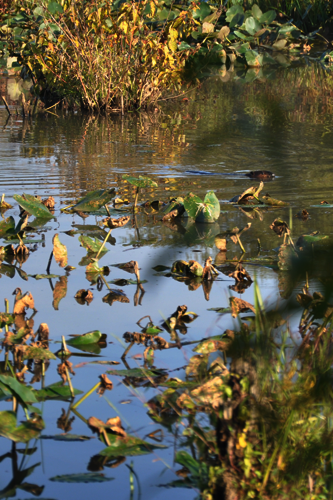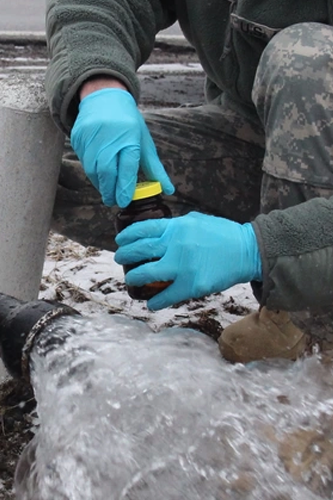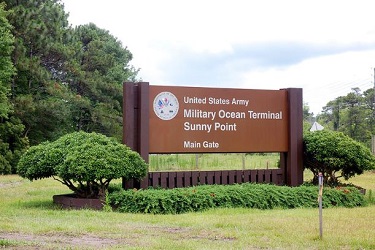Mission
Military Ocean Terminal Sunny Point (MOTSU) is Military Surface Deployment and Distribution Command’s East Coast strategic ammunition port, and is DOD’s primary ammunition seaport supporting the European, African and Middle Eastern areas of operation.
Introduction
Activated in 1955, MOTSU is located on the west bank of the Cape Fear River in Brunswick County, North Carolina. Encompassing more than 16,000 acres, MOTSU is home to the 596th Transportation Brigade. The port has transferred munitions to every major armed conflict since it was established. As a key ammunition shipping point on the Atlantic coast, MOTSU stores and ships DOD ammunition, dangerous cargo and explosives, including small arms ammunition; artillery shells, fuses and propellants; ammunition for vehicle systems; and aircraft bombs and ammunition.
Capabilities & Mission Execution
MOTSU is the largest ammunition port in the nation. With a workforce of approximately 350 civilians, contractors and military personnel, the installation includes three wharves and incorporates a network of railroad tracks to move munitions across the area. This infrastructure allows the seamless transfer of munitions between rail, trucks and ships. MOTSU enables the U.S. Army to meet its wartime ammunition throughput requirements.
MOTSU Environmental Programs
Since its opening in 1955, MOTSU has aimed to be an excellent neighbor and land steward. In cooperation with the local, state and federal agencies, in addition to numerous stakeholders, MOTSU has made conscious decisions to promote conservation efforts to maintain the natural habitat around and within the installation. MOTSU is committed to the restoration of natural communities as the primary means of conserving biodiversity, recovering endangered species, improving wildlife habitat, and increasing the efficiency of military shipping while prioritizing the safety requirements of the installation. This is achieved through the Sikes Act, which provides for cooperation by the Department of the Interior and the Department of Defense with state agencies in planning, maintenance, and development of natural resources on U.S. military installations while allowing for these lands to meet the needs of the installation.
If an environmental document does not open, try:
- Right click on the document
- Select either open in new tab or open in new window
National Environmental Policy Act (NEPA) Documents
|
| |
| |
|
|
Endangered
In accordance with the ESA and Sikes Act, MOTSU works to assist in the recovery efforts of all listed federally protected species and their habitats that are currently under the Army’s land management authority. This includes the management and monitoring of rare, threatened, and endangered species. The most important federally listed species occurring on and managed at MOTSU include the red-cockaded woodpecker (RCW) (shown right) and rough-leaved loosestrife (RLL). Red-cockaded woodpeckers (Dryobates borealis) are an endangered, non-migratory bird species that is currently located in the remaining fragments of suitable pine forests in the southeastern U.S. Other protected species include the piping plover, seabeach amaranth, northern long-eared bat, West Indian manatee, American alligator, Atlantic and shortnose sturgeon, and four species of marine turtles (green, loggerhead, leatherback, and Kemp’s Ridley). MOTSU and the surrounding area is also home to a diverse community of non-threatened mammals, birds, reptiles, fish, and amphibians. |  |
Forestry
MOTSU has several conservation and managed lands on and adjacent to its property. The primary goal of the land management programs that oversee these areas is the conservation of biodiversity and ecosystem function. Improvement of terrestrial habitat is largely facilitated using controlled burns, which are the most efficient and beneficial improvement method. These burns improve wildlife habitat by creating increased diversity of habitat types, increased space, and increased abundance of small plant species with high growth rates. Twenty distinct forest types (according to the combination of species) exist in the forested lands of MOTSU. Since MOTSU’s acquisition in 1954, nearly 1,100 acres have been planted or reforested with loblolly pine (Pinus taeda), longleaf pine (P. palustris) (shown right), slash pine (P. elliottii), and bald cypress (Taxodium distichum) seedlings. Within the MOTSU woodlands, pine trees are managed for maximum sustainable timber production while maintaining consistency with the requirements for threatened and endangered species present in the area, specifically RCW and RLL. |  |
Wetlands
The U.S. Army Corps of Engineers (USACE) and Environmental Protection Agency (EPA) jointly define wetlands as those areas that are inundated or saturated by surface or ground water at a frequency and duration sufficient to support, and that under normal circumstances do support, a prevalence of vegetation typically adapted for life in saturated soil conditions (Federal Register 1980 and 1982). MOTSU’s procedures to protect and improve the water quality in existing surface waters and wetlands extends to the streams, creeks, estuaries, and navigable waterways located on and adjacent to the installation, which feed into the Cape Fear Basin. MOTSU uses a watershed management approach to protect water quality and conserve aquatic resources. Regular monitoring programs are used to identify potential erosion problems and any associated sedimentation impacts to wetlands and streams. |  |
Water Tests
The per-and polyfluoroalkl substances (PFAS) are a group of chemicals used to make fluoropolymer coatings and products that resist heat, oil, stains, grease, and water. Fluoropolymer coatings can be in a variety of products. These include clothing, furniture, adhesives, food packaging, heat-resistant non-stick cooking surfaces, and the insulation of electrical wire. Many PFAS, including perfluorooctane sulfonic acid (PFOS) and perfluorooctanoic acid (PFOA), are a concern because they: PFAS are found in rivers and lakes and in many types of animals on land and in the water. PFAS persist in the environment and exposure in people can occur by consuming PFAS-contaminated water or food. Exposure may happen by using products that contain PFAS. |  |
NEPA
The National Environmental Policy Act (NEPA) of 1969 was created to ensure federal agencies consider the environmental impacts of their actions and decisions. Federal agencies are required to systematically assess the environmental impacts of their proposed actions and consider alternative ways of accomplishing their missions, which are less damaging to and protective of the environment. The three (3) primary NEPA documents are Categorical Exclusions, Environmental Assessments and Environmental Impact Statements. Categorical Exclusions (CATEXs) are applicable when a proposed action would not individually or cumulatively cause a significant impact on the human environment, or matches a category in the Agency’s list of CATEXs in their published NEPA Regulations, or consider extraordinary circumstances such as potential effects to environmentally sensitive areas or resources (listed species, cultural or historic properties, wetlands, cumulative impacts), and/ or where there is public controversy over the environmental effects of the agency's proposed actions or science. Environmental Assessments are applicable when a proposed action is not eligible for a CATEX, or would not cause significant, adverse environmental effects. A Finding of No Significant Impact (FONSI) is written and recorded. Environmental Impact Statements are applicable when a proposed action does not qualify for a CATEX or FONSI, and the proposed action might cause significant, adverse environmental effects (degradation of the environment or significant threat or hazard to public health or safety) or might have substantial environmental controversy concerning the significance or nature of the environmental impact of the proposed action. A Record of Decision (ROD) is written and recorded in the Federal Register.
Follow javascript: SP.SOD.executeFunc('followingcommon.js', 'FollowDoc', function() { FollowDoc('{ListId}', {ItemId}); }); 0x0 0x0 ContentType 0x01 1100 Compliance Details javascript:if (typeof CalloutManager !== 'undefined' && Boolean(CalloutManager) && Boolean(CalloutManager.closeAll)) CalloutManager.closeAll(); commonShowModalDialog('{SiteUrl}'+
'/_layouts/15/itemexpiration.aspx'
+'?ID={ItemId}&List={ListId}', 'center:1;dialogHeight:500px;dialogWidth:500px;resizable:yes;status:no;location:no;menubar:no;help:no', function GotoPageAfterClose(pageid){if(pageid == 'hold') {STSNavigate(unescape(decodeURI('{SiteUrl}'))+
'/_layouts/15/hold.aspx'
+'?ID={ItemId}&List={ListId}'); return false;} if(pageid == 'audit') {STSNavigate(unescape(decodeURI('{SiteUrl}'))+
'/_layouts/15/Reporting.aspx'
+'?Category=Auditing&backtype=item&ID={ItemId}&List={ListId}'); return false;} if(pageid == 'config') {STSNavigate(unescape(decodeURI('{SiteUrl}'))+
'/_layouts/15/expirationconfig.aspx'
+'?ID={ItemId}&List={ListId}'); return false;}}, null); 0x0 0x1 ContentType 0x01 898 Document Set Version History /_layouts/15/images/versions.gif?rev=40 javascript:SP.UI.ModalDialog.ShowPopupDialog('{SiteUrl}'+
'/_layouts/15/DocSetVersions.aspx'
+ '?List={ListId}&ID={ItemId}') 0x0 0x0 ContentType 0x0120D520 330 Send To other location /_layouts/15/images/sendOtherLoc.gif?rev=40 javascript:GoToPage('{SiteUrl}' +
'/_layouts/15/docsetsend.aspx'
+ '?List={ListId}&ID={ItemId}') 0x0 0x0 ContentType 0x0120D520 350
|
|

Contact Us
6280 Sunny Point Road
Southport, NC 28461 Comm: 910-457-8000
DSN: 488-8000
|
